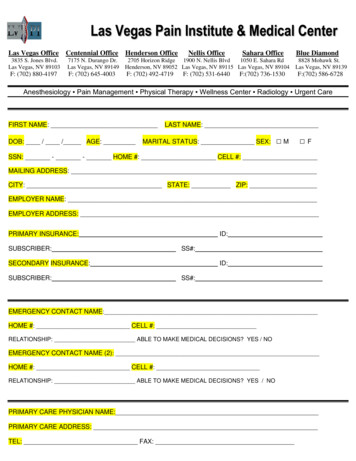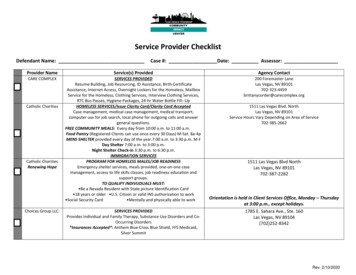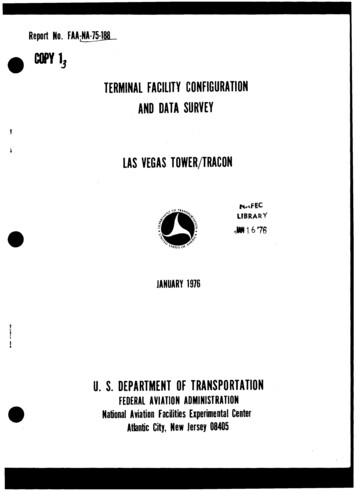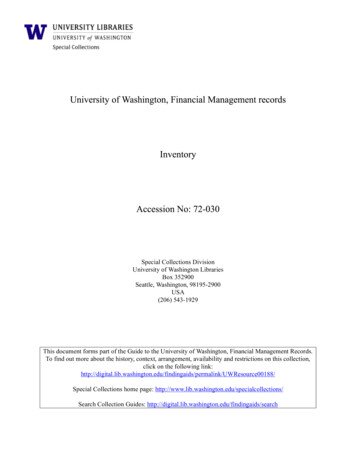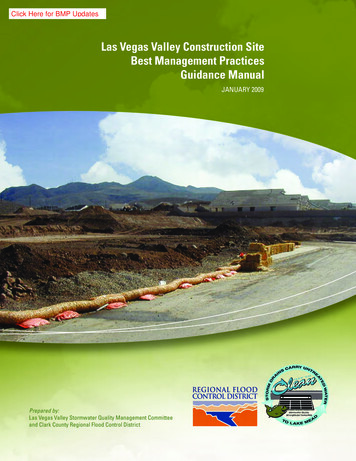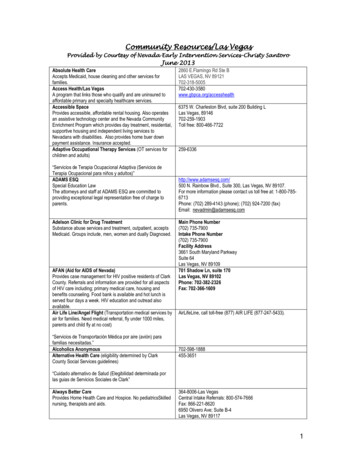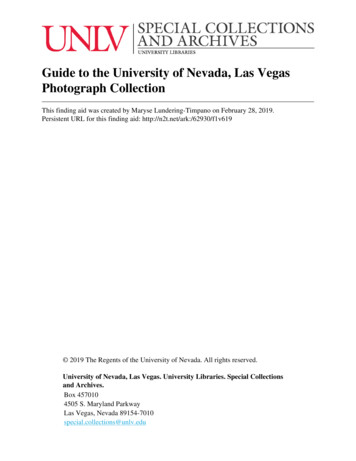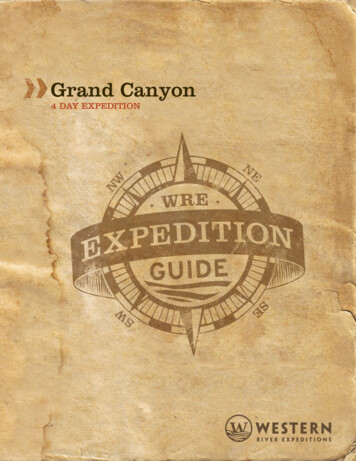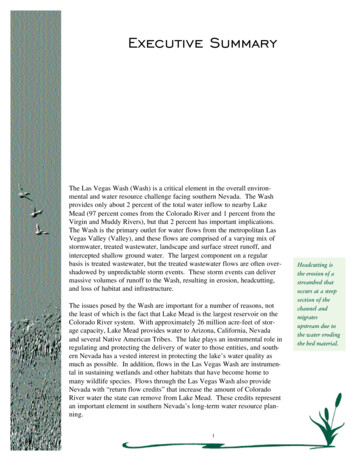
Transcription
Executive SummaryThe Las Vegas Wash (Wash) is a critical element in the overall environmental and water resource challenge facing southern Nevada. The Washprovides only about 2 percent of the total water inflow to nearby LakeMead (97 percent comes from the Colorado River and 1 percent from theVirgin and Muddy Rivers), but that 2 percent has important implications.The Wash is the primary outlet for water flows from the metropolitan LasVegas Valley (Valley), and these flows are comprised of a varying mix ofstormwater, treated wastewater, landscape and surface street runoff, andintercepted shallow ground water. The largest component on a regularbasis is treated wastewater, but the treated wastewater flows are often overshadowed by unpredictable storm events. These storm events can delivermassive volumes of runoff to the Wash, resulting in erosion, headcutting,and loss of habitat and infrastructure.The issues posed by the Wash are important for a number of reasons, notthe least of which is the fact that Lake Mead is the largest reservoir on theColorado River system. With approximately 26 million acre-feet of storage capacity, Lake Mead provides water to Arizona, California, Nevadaand several Native American Tribes. The lake plays an instrumental role inregulating and protecting the delivery of water to those entities, and southern Nevada has a vested interest in protecting the lake’s water quality asmuch as possible. In addition, flows in the Las Vegas Wash are instrumental in sustaining wetlands and other habitats that have become home tomany wildlife species. Flows through the Las Vegas Wash also provideNevada with “return flow credits” that increase the amount of ColoradoRiver water the state can remove from Lake Mead. These credits representan important element in southern Nevada’s long-term water resource planning.1Headcutting isthe erosion of astreambed thatoccurs at a steepsection of thechannel andmigratesupstream due tothe water erodingthe bed material.
Executive SummaryFor thousands of years Las Vegas, meaning “meadows” in Spanish, hasbeen a source of water in the dry Mojave Desert. These meadows, or wetlands, were supported by a spring complex known as the Big Springs,which were located in the central part of the Valley, the area now boundedby U. S. 95, Alta Drive, and Valley View Boulevard. Las Vegas Creek wasformed by these springs and flowed through the central Valley, percolatinginto the ground-water system before it could reach the lower part of LasVegas Wash. What is now considered the lower Las Vegas Wash wasephemeral with the exception of a small spring and wetland area, near whatis now known as Three Kids Wash. The Big Springs and associated wetlands began to decline and finally disappear as the Valley developed andground-water extraction increased to meet the populations needs.However, with urbanization, wetlands developed in the early 1950’s nearwhat is now Charleston Boulevard and Boulder Highway, due to the collection and discharge of wastewater.The Las Vegas Valley has changed dramatically in the last 50 years, andthe changes have had significant effects on the Las Vegas Wash.Increasing flows of treated wastewater transformed a once ephemeraldesert wash into a perennial system supporting an extensive marshland ofcattails and abundant wildlife. During the 1970s, flows in the Las VegasWash fed about 2,000 acres of wetlands (Figure A) and provided habitat tomore than 300 species of birds, mammals, reptiles, and fish. Today (FigureB), approximately150 - 160 milliongallons of watermove through theWash each day – anamount that can risedramatically duringstorms and heavyflood events. Theresulting erosion hascarved into thebanks of the Wash,destabilizing thechannel and increasing sedimentationinto Las Vegas Bay,the place where theWash enters LakeMead. WetlandsFigure A – Las Vegas Wash, 1970 (Vernon Bostick).have declined toabout 200 - 300 acres, and recent years have seen an increase in waterquality concerns with the discovery of contaminants such as perchlorateand urban chemicals in flows from the Wash.2
Executive SummaryAddressing the situation is not an easytask. There aremore than two dozenlocal, state and federal agencies withtheir own responsibilities, authoritiesand scope of activities in or around theLas Vegas Wash.Many past efforts toreverse the continuing erosion of theWash, while seriousand committed innature, were difficult Figure B – Las Vegas Wash following rain event, 1999(Southern Nevada Water Authority).to coordinate anddid not involve allstakeholders. The Las Vegas Wash Coordination Committee (LVWCC) hasundertaken a comprehensive approach, relying on full stakeholder involvement, to addressing and managing the issues posed by the Las Vegas Wash.The Road to Comprehensive ManagementThe Las Vegas Wash Coordination Committee is the outcome of two publicprocesses that began in 1997. In response to growing concerns over waterquality issues in Lake Mead and the Las Vegas Wash, the Nevada Divisionof Environmental Protection (NDEP) initiated the Lake Mead WaterQuality Forum (Forum) in February 1997. The Forum meets monthly andis comprised of local, state and federal agencies with an interest in LakeMead environmental issues and water quality standards. To provide theForum with public input and recommendations in the area of water quality,the Southern Nevada Water Authority (SNWA) established a Water QualityCitizens Advisory Committee (WQCAC) in July 1997. The WQCAC mettwice each month and was comprised of local citizens with an interest inwater quality issues.During 1997 and 1998, these two groups met separately to discuss andshare issues concerning Lake Mead and the Las Vegas Wash. TheWQCAC ultimately developed recommendations in nine areas. These recommendations were presented to the Southern Nevada Water AuthorityBoard of Directors and the Lake Mead Water Quality Forum in June andJuly 1998, respectively.One of the WQCAC’s recommendations was the development of a comprehensive plan for the long-term management of the Las Vegas Wash.3
Executive SummaryThe committee suggested that the plan should be a consensus-based document prepared jointly with stakeholder groups and agencies. The processshould also provide opportunities for substantial public involvement aswell as input from the WQCAC. The plan should address such issues asimplementation, existing institutional mechanisms to perform work, funding, and the need for additional authorities, if necessary.Because the Las Vegas Wash is surrounded by many complex issues and isnot the responsibility of any one public entity, the WQCAC concluded thatan interagency and community-wide effort was neededLas Vegas Wash Coordination to address the situation. The WQCAC’s ninth andfinal recommendation was that the development of aCommittee Memberscomprehensive management plan should be coordinatlCity of Hendersoned through the SNWA, an existing entity comprised oflCity of Las Vegasseven municipal water and wastewater entities thatlCity of North Las Vegashave responsibility for a variety of water resourcelClark County Sanitation Districtissues in the Las Vegas Valley. The Lake Mead WaterlClark County Departments ofQuality Forum agreed and the Las Vegas WashComprehensive Planning and Parks andCoordination Committee was formed.RecreationlllllllllllllllllllllClark County Health DistrictClark County Regional FloodControl DistrictSouthern Nevada Water AuthorityBasic Management, Inc.Lake Las Vegas ResortLas Vegas Bay Marina OwnerWater Quality Citizens AdvisoryCommittee (2 members)Friends of the Desert Wetlands ParkUniversity of Nevada, Las VegasNevada Division of WildlifeNevada Division of EnvironmentalProtectionNevada State Health DivisionConservation District of SouthernNevadaColorado River CommissionNational Park ServiceU.S. Bureau of ReclamationU.S. Corps of EngineersU.S. Environmental Protection AgencyU.S. Fish & Wildlife ServiceU.S. Geological SurveyU.S. Natural Resources ConservationServiceThe Las Vegas WashCoordination CommitteeIn the summer of 1998, the Southern Nevada WaterAuthority developed and implemented an action planoutlining the membership of the Las Vegas WashCoordination Committee. The action plan provided aframework for the LVWCC process and established atimeline for specific goals. In September 1998, theSNWA established a project coordination team to provide administrative and technical support to theLVWCC. One month later, the Las Vegas WashCoordination Committee convened for the first time.To support the LVWCC in its first year, participatingentities have committed considerable staff andresources.The Las Vegas Wash Coordination Committee combines local, state, and federal agencies with membersof the public, business people, and representatives ofenvironmental groups.To facilitate the vast amount of work required to develop a comprehensive management plan, study teamswere implemented as part of the LVWCC process.While the committee focused on conceptual and strategic direction for stabilization and enhancement of the Las Vegas Wash, the study teams4
Executive Summaryfocused on issues or concerns in specific areas. The study team areas wereselected in accordance with issues identified by the Water Quality CitizensAdvisory Committee, the Lake Mead Water Quality Forum, and the LasVegas Wash Coordination Committee.Las Vegas Wash Coordination CommitteeStudy TeamsTo accomplish their work, the study teams drew upon staff from existingagencies, outside experts and other sources. More than140 individuals participated in the study team activiLas Vegas Wash Coordinationties. Each team met at least monthly, discussed andCommittee Study Teamsresearched issues, and developed recommendations forconsideration by the Las Vegas Wash Coordinationl Jurisdictional & RegulatoryCommittee. The recommended actions resulting froml Erosion & Stormwaterthe study team activities provide the basis from whichl Wetlands Parkwill evolve a long-term management program to stabil Alternate Dischargelize and restore the Las Vegas Wash. The recommendl Shallow Ground Watered actions are described in more detail in Study Teaml Environmental ResourcesChapters 6 through 14 and in Section IV, Summary ofRecommendations.l Land Usel Public Outreachl FundingThe Comprehensive AdaptiveManagement PlanTo facilitate long-term planning and implementation ofsolutions for the Las Vegas Wash, the Las Vegas Wash CoordinationCommittee, under recommendations from the Water Quality CitizensAdvisory Committee, set as their goal the development of a comprehensiveplan that would provide a roadmap for the long-term stabilization,enhancement, and management of the Wash. In developing the plan, theLVWCC wanted to ensure that the content was comprehensive in nature,covering all the important issues facing the Wash, but also was easilyadaptable, in order to reflect the changing conditions and needs.The Las Vegas Wash Comprehensive Adaptive Management Plan(LVWCAMP) is not intended to be a capital improvement plan, focusingjust on implementing engineering solutions. This document serves as thebasis from which to implement the 44 actions recommended by the studyteams and as a guidance instrument from which to develop a long-termmanagement plan under full stakeholder involvement. A specific timelinewas intentionally not included in this document in order to maintain theflexibility and adaptability desired. It is anticipated that once some of thekey “initial steps” (discussed in the next section) occur, the oversight entitywith the LVWCC will be in a better position to develop goal-specifictimelines.Since it was the desire of the LVWCC to develop the LVWCAMP underfull stakeholder involvement, an intensive five-week comment period was5
Executive Summaryhighlighted by presentations of the document to the full Las Vegas WashCoordination Committee, the Water Quality Citizens Advisory Committee,and five community workshops designed to seek public input. The document was also made available on the LVWCC Web site (www.lvwash.org).The public outreach process was successful. More than 230 commentswere reviewed and incorporated, as applicable, into the final document.Efforts were made to make revisions that would be acceptable to allLVWCC entities and not to express opinions reflective of just one or a fewentities. All comments are summarized, along with an explanation of theaction taken regarding incorporation into the document, in Appendix 15,Summary of Comments and Responses.Initial StepsTo begin meeting the challenges of stabilizing, restoring, and managing theLas Vegas Wash, certain actions must precede others. The following threeinitial steps provide the foundation for the implementation of theLVWCAMP and the long-term management of the Las Vegas Wash.Form an agency to oversee and coordinate themanagement and restoration of the Wash.Following a series of analyses and discussions, the Jurisdictional &Regulatory Study Team concluded that implementation of the comprehensive adaptive management plan should follow the Southern NevadaStrategic Planning Authority recommendations that such issues should behandled by a local entity. Administering the plan’s implementation fromwithin the local community would ensure accountability at the most immediate level. Local control would also allow for more responsive andinformed decision-making. Forming this management entity is one of thefirst steps to be taken if the process of comprehensive adaptive management is to be realized.After considering several possible models, the study team narrowed itsfocus to two options. Option 1 was to establish a new joint powers authority whose members would be comprised of appropriate local entities suchas those mentioned above. Option 2 was to utilize existing local agenciesthrough interlocal agreements to administer and implement theComprehensive Management Plan.The team identified several entities in the Las Vegas Valley with thestaffing, expertise, support infrastructure, or scope of activities in place totackle many of the challenges associated with managing and restoring theLas Vegas Wash. These entities are Clark County, Clark County RegionalFlood Control District, Clark County Sanitation District, ConservationDistrict of Southern Nevada and the Southern Nevada Water Authority.6
Executive SummaryMany of the local agencies support utilization of an existing board orauthority with the creation of interlocal agreements with appropriate agencies. They are recommending the Southern Nevada Water Authority bedesignated the lead agency which would enter into interlocal agreementswith various local agencies as necessary to implement the comprehensiveadaptive management plan. For example, interlocal agreements would benecessary with Clark County Parks and Recreation for construction andmanagement of the Clark County Wetlands Park and with Clark CountyRegional Flood Control for flood control facilities in Las Vegas Wash.Stabilize the Wash.Another important step is to stabilize the existing environment in the Wash.A report outlining possible actions was developed as the result of a twoday engineering workshop conducted by the Las Vegas Wash CoordinationCommittee in August 1999, and subsequent analysis by the Erosion &Stormwater Study Team.The workshop brought together engineering professionals from privatefirms, local and regional public entities, and other organizations with anexpertise in environmental restoration projects. Participants developed consensus on the issues surrounding the Wash and delved into specific methods that could be used in an overall stabilization plan for the Wash. Thediscussions covered types and methods of structures, development priorities, and studies needed to understand the dynamics of the Wash morefully. Specific action items were developed to address each conclusion andcan be found in the recommendations from the Erosion & StormwaterStudy Team in Chapter 6. The workshop yielded the following three conclusions:Erosion in the Las Vegas Wash needs immediate attention. TheWash must be stabilized as soon as possible to implement any planfor a wetlands park or comprehensive management of the Washecosystem. Changing topography has forced the redesign of erosioncontrol structures in the Wash, and if not addressed, these conditionswill make it difficult to design and implement any kind of facilitiesor management options.Dry weather flows (treated wastewater, shallow ground water,and urban runoff) should be considered separately fromstormwater flows. Since the dry weather flow volume (about 240cubic feet per second) is significantly less than storm flow (rangingfrom 500 to 10,000 cubic feet per second), it is prudent to considerany engineering solutions based on the individual flows.7
Executive SummaryAny reestablishment of wetland areas on a large scale must bedone “off-stream” or out of the Wash channel. Some wetlandswill be created in the channel of the Las Vegas Wash through installation of erosion control structures and the resulting ponding of waterthat will occur behind those structures. But erosion and headcuttingin the Wash itself will likely preclude the establishment of large areasof wetlands in the channel itself. Instead, any large area of wetlands(more than what will be created behind each structure) to be developed will need to be designed off-stream from the main wash channel.Make decisions regarding the amount ofin- and off-stream wetlands needed.Given the possibility of limited wetland development in the channel of theLas Vegas Wash as indicated in the previous Initial Step, it is critical thatdecisions be made concerning how many acres of wetlands (and land) areneeded for both in- and off-stream. This step is essential in order to definethe most feasible location of where wetlands can be developed, and toensure any ongoing actions to stabilize the Wash complement the goal ofwetland development.By taking these first incremental steps, the process of actively restoringand managing the Las Vegas Wash can begin. This process will involve anumber of concurrent actions tied to the recommendations of the ninestudy teams. These actions, in turn, will support the development of themore long-term restoration and management activities that are the objective of this Las Vegas Wash Comprehensive Adaptive Management Plan.Key RecommendationsThe following key recommendations summarize the most important actionsdeveloped by the study teams, in general order of priority. The actions arenot exclusive or independent of the many other recommendations contained in this plan; rather, they have been highlighted to give the reader asense of the larger activities required to begin restoring and managing theWash. A complete list of all study team recommendations is provided inSection IV of this plan. The activities of each study team are described inmore detail in Chapters 6 through 14.Action:Define the structure for local oversight of the Las VegasWash Comprehensive Adaptive Management Plan.To ensure successful coordination and implementation, the Jurisdictional &Regulatory Study Team recommended that one oversight body be identi8
Executive Summaryfied to implement the LVWCAMP and manage the Las Vegas Wash intothe future. For the purposes of this plan, this oversight body will be calledthe “Las Vegas Wash Management Entity.”This action item follows the lead established by the Southern NevadaStrategic Planning Authority, which recommended that regional issues insouthern Nevada be addressed locally and that local agencies employmechanisms such as interlocal agreements, when necessary, to organizethemselves for such activities. Agencies throughout the Las Vegas Valleycurrently use interlocal agreements for various purposes such as wastewater treatment. For this reason, the Jurisdicational & Regulatory StudyTeam believed interlocal agreements or Memorandums of Agreement(MOAs) could be used to facilitate jurisdictional relationships as well.Action:Install erosion control structures.To aid in stabilizing the Wash as soon as possible, the Erosion &Stormwater Study Team recommended the development of prototype structures that can be installed quickly and that are less expensive than permanent structures. Suggested conceptual designs include utilization ofgabions, sheet pile, cellular coffer dams, inflatable dams, bio-engineereddams (using vegetation for stabilization), rip rap filled dams and geotextileenvelopes. Two conceptual designs, and their associated cross-sectionviews, are shown in Figures C, D, E and F.As a corollary to this, an engineering analysis should be conducted to identify specific sites for installation of the prototype structures. Existing studies have already identified potential sites for approximately 15 erosion control structures, which would help stabilize the channel and reduce catastrophic erosional events. As a result of the engineering workshop, thesites were reviewed and five priority sites were identified (Figure G). Thefive priority sites include:lllllA site downstream of Clark County’s Advanced Wastewater TreatmentPlant dischargeA site downstream from the confluence of Duck Creek and the WashThe site of the Pabco Road Erosion Control StructureThe site of the abandoned SNWA LateralA site near Three Kids Wash (also the site of the future water supplylateral)In addition, eight other potential sites (Figure H) have been identified bythe Southern Nevada Water Authority. The sites were selected on the basisof criteria such as active headcut location, property ownership and suitability for regulatory permitting and construction. These sites include fivelocations upstream from the Lake Las Vegas intake (1-5), two locations9
Executive SummaryFigure C – Plan view of prototype erosion control structure.Figure D – Cross section view of Figure C.10
Executive SummaryFigure E – Plan view of prototype erosion control structure.Figure F – Cross section view of Figure E.11
Executive SummaryFigure G – Five priority sites for construction of erosion control structures.downstream from Pabco Road (6 & 7) and one location upstream fromPabco Road (8). A complete discussion of the recommendations from theErosion & Stormwater Study Team is provided in Chapter 6.Action:Identify water resources needed to maintain the ClarkCounty Wetlands Park.The Wetlands Park Study Team recommended using the Las Vegas WashComprehensive Adaptive Management Plan as a vehicle for implementingthe master plan for the Clark County Wetlands Park (Park). When developing the park, careful consideration must be given to hydrology.Although still undetermined, a minimum daily flow and specific waterquality standards will be required for the maintenance of the parks’ vegetation and wildlife.Several hydrologic factors must be taken into account before extensivedevelopment of the park occurs, such as water depths, velocity, hydroperiod, salinity, nutrient levels, sedimentation rates and extensive water qualityanalyses. To answer these questions and guide water resource issues forthe Wetlands Park, the following tasks are recommended:llDetermine minimum daily in-stream flow requirements to maintain vegetation boundaries within the Park.Identify average daily water quantity available from each source ofwater in the Las Vegas Wash.12
Executive SummaryFigure H – Eight potential sites for construction of erosion control structures.llllllllDetermine the feasibility of securing a minimum daily in-stream flow tothe park.Examine characteristics of wetlands within the Park, such as soils,vegetation, water depth, flow over time, and other related processes, inorder to predict the impacts of wastewater and stormwater, as well asthe potential for water quality enhancement.Develop and initiate a study to monitor the impacts of wastewater andstormwater on vegetation within the Park. Use the results to adaptivelymanage wastewater and stormwater impacts over time.Identify water quality constituents and their values in each source ofwater in the Las Vegas Wash.Determine the range of water quality constituent values necessary tomaintain the continued health and viability of vegetation within thepark.Finalize and implement a sediment transport and sediment quality monitoring program.Develop and implement a water quality monitoring plan to monitorwater quality within the Las Vegas Wash. Use the results to adaptivelymanage water quality impacts over time.Work with the Alternate Discharge Study Team to determine the amountof treated wastewater flow needed for wetland/Park activities.13
Executive SummaryAction:Participate in and support the implementation of theAlternate Discharge Study conducted by the municipalwastewater dischargers (City of Henderson, City of LasVegas and Clark County Sanitation District).The Alternate Discharge Study Team recommended continued support ofefforts by the three wastewater dischargers to develop alternate dischargeoptions to manage current and future wastewater flows. This includes supporting the dischargers as they conduct the Scope of Services from theirAlternate Discharge Study (Appendix 8.2).The current Scope of Services focuses on project initiation, compilationand assessment of existing data, development of issues and constraints,interim alternative evaluation and an implementation plan for final consideration of options. The development of issues and constraints will lead toa workshop where the alternatives will be initially ranked and an interimlist selected for further evaluation. The interim alternative evaluation willinvolve further ranking of the alternatives based on additional information.The Alternate Discharge Study Team also recommended that the alternatedischarge options and selection criteria developed at the study team levelbe considered as a starting point during the initial process of identifyingpotential alternative discharge options. Using this available informationmeans the consultant can more quickly eliminate some discharge options,resulting in a time and cost-saving benefit to the dischargers. A completediscussion of the recommendations from the Alternate Discharge StudyTeam is provided in Chapter 8.Action:Establish off-stream wetlands and evaluate storm waterdetention/retention basins.The Erosion & Stormwater Study Team recommended that the Las VegasWash Coordination Committee and Las Vegas Wash Management Entitycontinue to work with the City of Henderson, the City of Las Vegas andthe Clark County Sanitation District to help define alternate dischargeoptions and the distribution of future flows in the Wash and off-streamwetland facilities. The study team also recommended investigating thepossibility of using abandoned gravel pits (Figure I) near the abandonedSNWA Lateral site for “skimming” peak stormwater flows. Potential sitesfor stormwater detention/retention basins further upstream of these sitesshould also be investigated and evaluated, as recommended by participantsin the August 1999 engineering workshop. A complete discussion of therecommendations from the Erosion & Stormwater Study Team is providedin Chapter 6.14
Executive SummaryFigure I – Abandoned gravel pits that could serve as detention/retentionbasins.Action:Conduct sediment transport modeling.The Erosion & Stormwater Study Team recommended that sediment transport modeling be conducted in conjunction with storm flow analysis. Thework should include a compilation of available stream hydraulics, hydrology, and geologic information on the Wash, development of preliminary stabilization techniques, development of a computer model of Wash streamhydraulics and channel scouring,modeling of stabilization measures anddifferent techniques, and determination of the best overall stabilizationapproach. A complete discussion of the recommendations from theErosion & Stormwater Study Team is provided in Chapter 6.Action:Develop long-term monitoring programs.Two study teams developed recommendations in the area of long-termmonitoring. The Wetlands Park Study Team recommended the development of a long-term, coordinated monitoring plan to ensure Clark Countymitigation requirements for monitoring within the Park are met. TheShallow Ground Water Study Team recommended implementation of along-term, coordinated monitoring program that measures water quality,conducts aquifer testing, identifies contributions from shallow groundwater inflows, identifies data gaps and identifies any need for additionalmonitoring wells. A complete discussion of the recommendations fromthe Shallow Ground Water Study Team and Wetlands Park Study Team areprovided in Chapters 7 and 9, respectively.15
Executive SummaryAction:Develop a central database for shallow ground water information.The Shallow Ground Water Study Team recommended that a central database be developed to include all known data on the shallow ground watersystem. The database should include, at a minimum, data on well construction, location, water level, water quality and aquifer testing. The LasVegas Wash Project Coordination Team has already begun this effort byreviewing more than one hundred reports produced by Basic Management,Inc. (BMI) and submitted to the Nevada Division of EnvironmentalProtection. Relevant data has been extracted from these reports andentered into a database. The database will be made available to all entitieswith an interest in shallow ground water. A complete discussion of the recommendations from the Shallow Ground Water Study Team is provided inChapter 7.Action:Support the development and implementation of a standardized environmental review process among planning entities.The Land Use Study Team recommended the development of a commonenvironmental review process among planning entities, not only to speedup the process for internal and external customers, but also to clarify to theparty requesting a zoning change or variance exactly what is required.
stakeholders. The Las Vegas Wash Coordination Committee (LVWCC) has undertaken a comprehensive approach, relying on full stakeholder involve-ment, to addressing and managing the issues posed by the Las Vegas Wash. The Road to Comprehensive Management The Las Vegas Wash Coordination Committee is the outcome of two public processes that began in .
